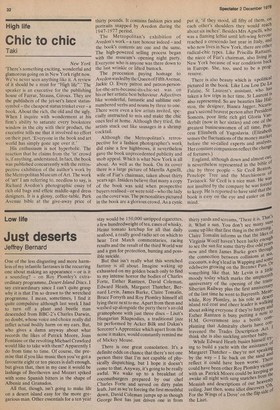High life
Chic to chic
Taki
New York 'There's something exciting, wonderful and glamorous going on in New York right now. We've never seen anything like it. A review of it should be a must for "High life".' The speaker is an executive for the publishing house of Farrar, Strauss, Giroux. They are the publishers of the jet-sees latest statussymbol — the cheapest status trinket ever — a book. About the rich, the old and the ugly. When I inquire with wonderment at his firm's ability to saturate every bookstore window in the city with their product, the executive tells me that it involved no effort on their part. 'Everyone in the book and art world has simply gone ape over it.'
His enthusiasm is not hyperbolic. The reaction that he claims from the 'in' crowd is, if anything, understated. In fact, the book was published concurrently with the retrospective exhibition of the author's work by the Metropolitan Museum of Art. The work of 'art' I am referring to, needless to say, is Richard Avedon's photographic essay la rich old bags and effete middle-aged dress designers. It is a glossy, coffee-table, Park Avenue bible at the give-away price of thirty pounds. It contains fashion pies and portraits snapped by Avedon during the 1947-1977 period.
The Metropolitan's exhibition of Avedon's work — a rare honour indeed — and the book's contents are one and the same. The high-powered selling process began with the museum's opening night party. Everyone who is anyone was there down to the *last wrinkle or lifted buttock.
The procession paying homage to Aveclon was led by the Queen of Fifth Avenue, Jackie 0. Every patron and patron-personfor-the-arts-because-its-chic-set was on his or her artistic best behaviour. Adjectives like wonderful, fantastic and sublime outnumbered verbs and nouns by three to one. There were even a few artists invited, specially instructed to mix and make the chic ones feel at home. Although they tried, the artists stuck out like sausages in a shrimp cocktail.
Although the Metropolitan's retrospective for a fashion photographer's work, did raise a few highbrows, it nevertheless gave the book unprecedented publicity and snob appeal. Which is what New York is all about. As well as the book. On its cover there is a large picture of Marella Agnelli, wife of Fiat's chairman, taken about thirty years ago. Insiders believe that many a copy of the book was sold when prospective buyers realised —or were told— who the lady on the cover was. The personalities pictured in the book are a glorious crowd. As a cynic put it, 'if they stood, all fifty of them, 00 each other's shoulders they would reach about six inches'. Besides Mrs Agnelli, who was a flaming leftist until left-wing fervour reached a crescendo last year in Italy, and who now lives in New York, there are other radical-chic types. Like Priscilla Rattazzi, the niece of Fiat's chairman, also living in New York because of war conditions back in Europe. She, too, used to be a progressive.
There is also beauty which is apolitical pictured in the book. Like Lou Lou De La Falaise, St Laurent's assistant, who has taken a few trips in her time. St Laurent is also represented. So are beauties like Hal" ston, the designer, Bianca Jagger, NiCara" gua's second bravest person after President Somoza, poor little rich girl Gloria Vanderbilt (now in her sixties) and one of the greatest businesswomen of all time, Prin' cess Elizabeth of Yugoslavia. (Elizabeth senses the fluctuations of the money market before the so-called experts and analysts. Her constant companions reflect the change of Ef onrgtluanneds;)although down and almost 011t; is nevertheless represented in the bible 01. chic by three people — Sir Cecil Beat011', Penelope Tree and the Marchioness 0' Tavistock. Sir Cecil is a nice man. He wa5 not insulted by the company he was forceu to keep. He is reported to have said that the book is easy on the eye and easier on the mind.






































 Previous page
Previous page